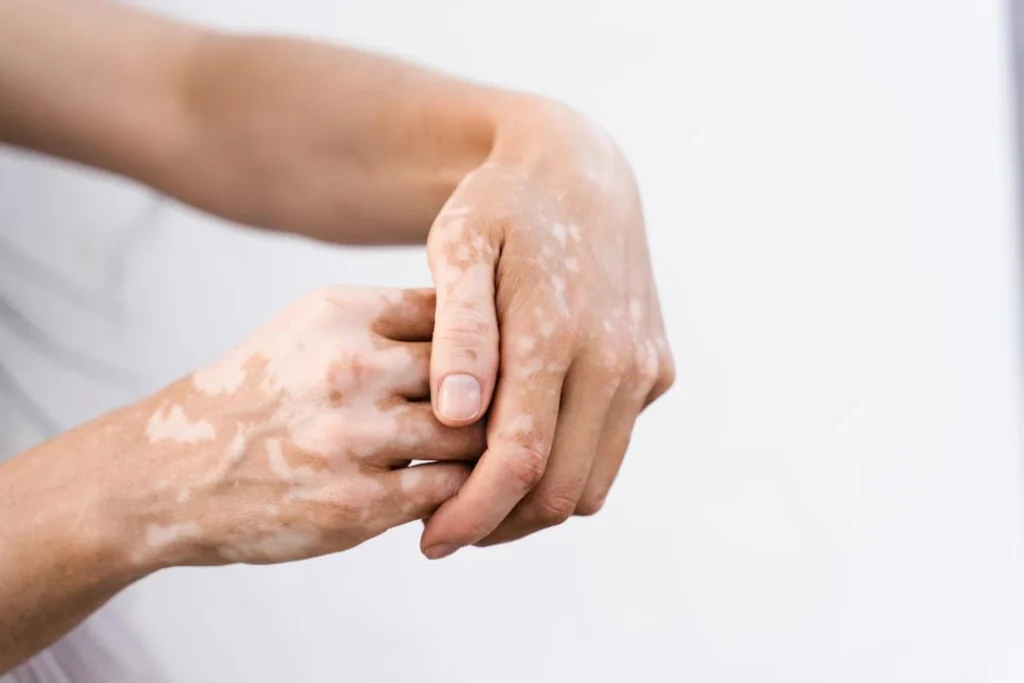Vitiligo is a skin condition characterized by the loss of pigmentation in certain areas of the skin, leading to white patches that can appear anywhere on the body. This occurs when melanocytes, the cells responsible for producing skin pigment, stop functioning or are destroyed. While the exact cause of vitiligo isn’t fully comprehended, it is believed to be related to autoimmune factors, genetics, or environmental triggers. Although not physically harmful, vitiligo can significantly impact an individual’s self-esteem and emotional well-being.
Contact us today to schedule your consultation and start your journey to a brighter, more even complexion.

Dermestetics: Experts in Treating Vitiligo
At Dermestetics, located in Gainesville, VA, we specialize in diagnosing and treating vitiligo. Our team of skilled dermatologists and medical professionals is dedicated to providing customized care according to each patient’s unique needs. By using advanced diagnostic tools and the most recent treatment methods, we strive to restore skin color and enhance the quality of life for individuals with vitiligo. Our holistic approach guarantees patients receive the best and most compassionate care possible.


What’s Great About Treating Vitiligo?
Learn More
Consultation Required?
Yes, a consultation is essential to determine the best treatment plan for your unique case of vitiligo.
Duration of Results
Results vary by individual, but with consistent treatment and maintenance, long-lasting improvements can be achieved.
Sessions Needed
Commonly, multiple sessions are required to achieve optimal results. The exact number depends on the severity and extent of the condition.
Downtime
Minimal to none; most treatments allow patients to resume daily activities instantly.
What It Treats
White patches of depigmented skin.
Uneven skin tone caused by loss of pigmentation.
Psychological effects associated with skin changes

How Our Treatment Process Works
How Our Treatment Process Works
Topical Treatments:
Vitiligo treatment often begins with topical medications, like corticosteroids or calcineurin inhibitors. These medications aim to lessen inflammation and encourage melanocytes—the cells responsible for skin pigmentation—to regain function. Applied directly to the depigmented areas, these treatments are most effective when initiated early, targeting newly developed patches to restore pigmentation.
Phototherapy:
Another effective method is phototherapy, particularly narrowband ultraviolet B (NB-UVB) therapy. This involves exposing the skin to specific UV wavelengths, stimulating melanocyte activity and promoting pigmentation in the affected areas. Phototherapy sessions are typically conducted two to three times per week over several months and are highly effective for widespread or stubborn vitiligo patches.
Surgical Interventions:
For cases of vitiligo that are stable and unresponsive to other treatments, surgical options such as melanocyte transplants or skin grafting may be employed. These procedures involve transferring healthy, pigment-producing cells or small sections of skin from unaffected areas to depigmented regions. This approach can provide long-lasting results but is generally reserved for individuals whose vitiligo has not progressed for a significant amount of time.
Complementary Treatments
Vitiligo treatment at Dermestetics can be enhanced with additional services for optimal results, such as:
- Microneedling: Stimulates skin regeneration to improve overall tone and texture.
- Medical-Grade Skincare Products: Maintains skin health and supports ongoing pigmentation restoration.
- Hydrating Facials: Enhances skin moisture and vitality, creating an ideal environment for treatment efficacy.
Get Started
Ready to discover the best Vitiligo treatments in gainesville?




